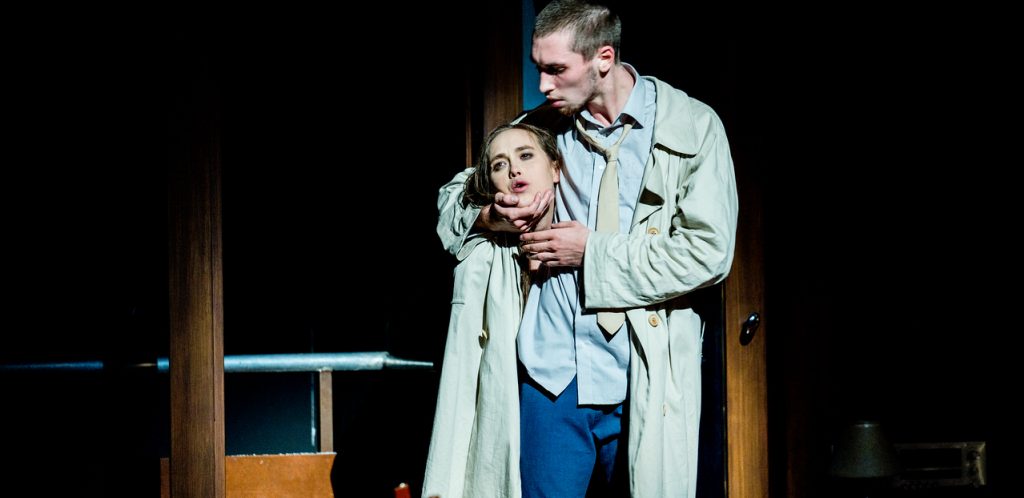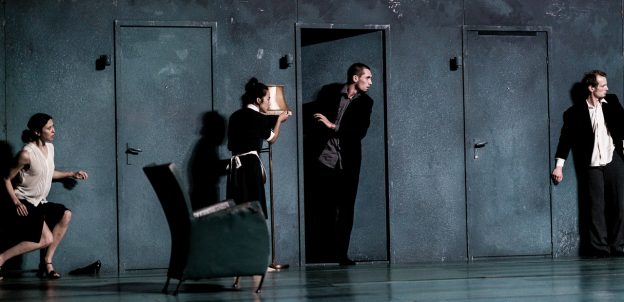We’re entering the final week of the last ever London International Mime Festival, which is bowing out with a bang. Dorothy Max Prior reflects on work seen to-date
January in London: cold, damp, miserable – same as it ever was. But January 2023 is extra miserable because added to the predictably dismal weather and usual midwinter gloominess we have post-pandemic ennui, post-Brexit chaos, continuing government lunacy, endless train and postal and NHS strikes, and more. Just don’t mention the war.
But there is a glimmer of light in the darkness – the London International Mime Festival (LIMF) is back, on full throttle, with fifteen productions (including eight international works) presented in eight different London venues.
So a buzz is in the air, but with this buzz comes the bittersweet knowledge that this year, its 47th year, will be the final edition of the Festival in its present form. Once it’s done and dusted, LIMF directors Helen Lannaghan and Joseph Seelig plan to continue working together to promote and support physical and visual theatre, in ways yet to be announced. But what they won’t be doing is programming a month-long festival every January…
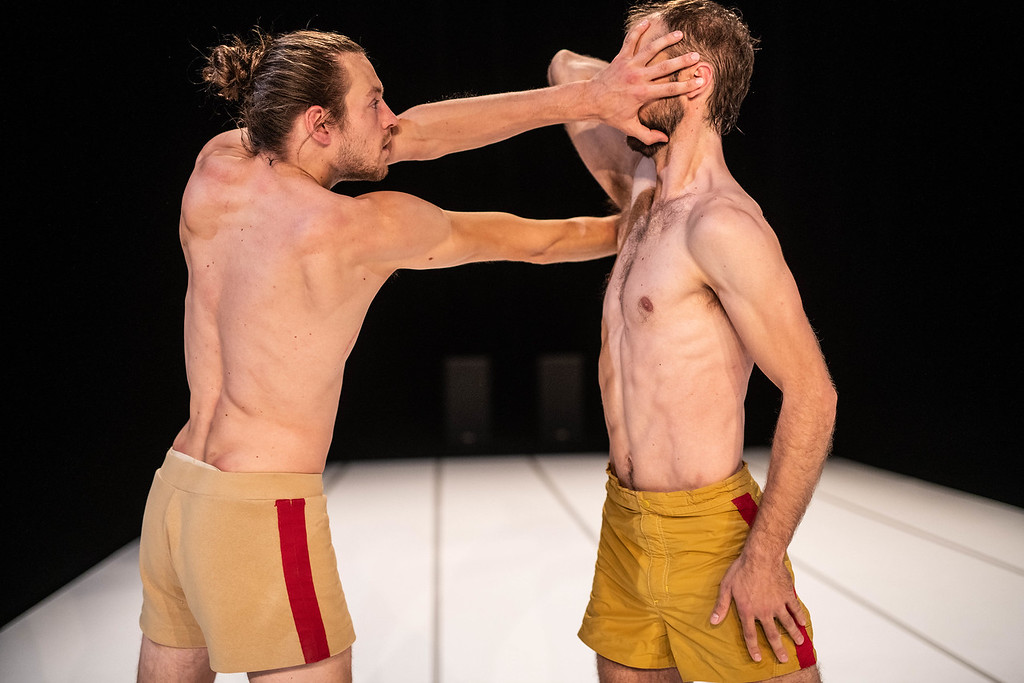
This year’s Festival kicked off on 16 January at The Place with the traditional launch gathering around a chocolate fountain, followed by the opening show by Alexander Vantournhout’s Not Standing, one of a number of Belgian companies in the 2023 programme. Through the Grapevine is Vantournhout’s third collaboration with fellow circus-dance artist Axel Guerin, a pas de deux in which these two exceptional physical performers play with their physical differences. And like most of LIMF shows, this one is playing to a full house.
On a sparse stage with simple lighting and no music, dressed minimally in sports shorts, bare-chested, the two bodies encounter each other. They measure up to the other, and they measure themselves in relation to the space, engaging with floor and walls in numerous novel ways. Just how many man-lengths are there to this dancefloor? Holding someone ‘at arm’s length’ takes on a new meaning as there is comic play on the difference in limb length between these two human specimens. The contact between them moves from cautious touches and twists, to grapples and shoves, to a full-on engagement that veers from contact improvisation to all-in wrestling, via capoeira. There is something Olympian about it all. The movement vocabulary shifts again, to full-on acrobalance poses, body supporting body in convoluted and often unexpected ways. A head balance prompts spontaneous audience applause. At around about the halfway mark, the sound of intense drumming kicks in, morphing into an ambient electronic soundscape. The sound of the recorded music is quite a shock after so long without it. Through the Grapevine is a virtuosic display of acrobatic skills. There is no doubting the talent on display here, and there’s novelty and humour a-plenty – but it’s my head rather than my heart that is impressed.
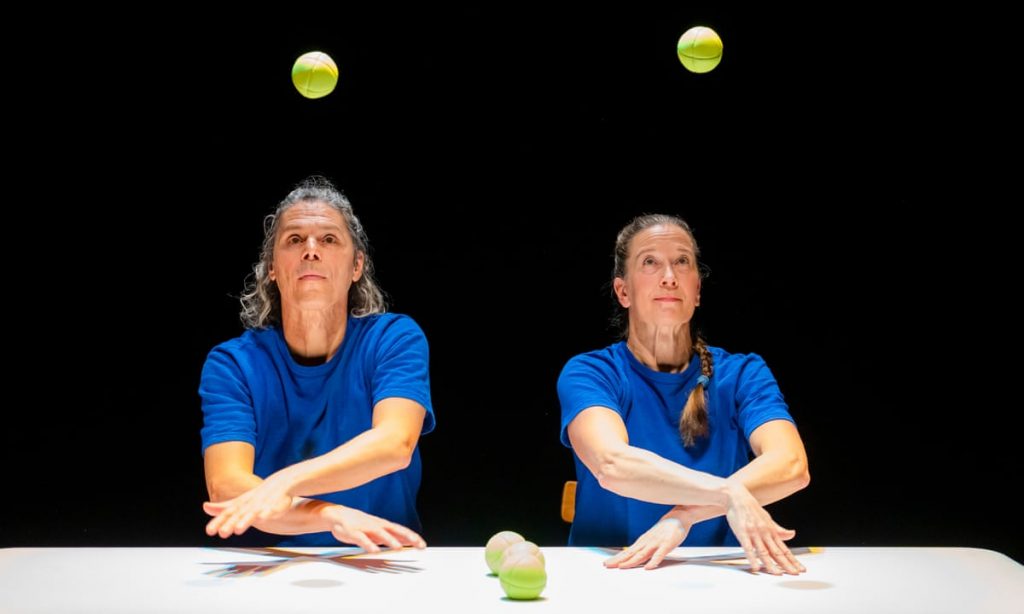
I’m back at The Place later in the week to see Gandini Juggling. And this time my heart is completely won over, right from the start. The Games We Play is a lecture-demonstration created especially for LIMF by company founder-directors Sean Gandini and Kati Ylä-Hokkala. These two have been playing games together for 30 years – they have a repertoire of around thirty productions staged more than six thousand times all over the world, indoors and out. Some of their work – such as the wonderful Smashed and its sequel, Smashed 2 – is created for a large ensemble of jugglers. Some, like 4×4: Ephemeral Architectures, pairs jugglers and dancers. But the core of the company has always been the personal and professional relationship of Sean and Kati, who bonded when working together in Ra Ra Zoo, and together formed Gandini Juggling in 1991. The Games We Play is a complete joy – and as with many earlier shows, brings Sean Gandini’s fascination with maths and magic together with Kati Ylä-Hokkala’s knowledge of and interest in rhythm and choreographic patterns. And of course both are top-notch jugglers.
We start in regular lecture-demonstration mode as we are given a breathless run-through of the juggling basics: the numbers and patterns and terminology. The three-ball basic up to four and five, in colourful cascades and fountains galore; then, they take us down from three to two to one to zero. Analogies are drawn to modern art as the patterns evolve: this one here is a Hockney, that one there a Rothko, and this final big explosion a Jackson Pollock. Sean lectures and Kati demonstrates. When we get to zero, Sean quips that this might be what most people would assume the mime festival to be: a lone Finnish woman onstage juggling invisible balls.
Then, Sean demonstrates, and Kati disrupts – dragging chairs across the stage, tipping the neatly arranged lines of red and green and pink and orange balls off the trestle table so that they run amok across the floor. Sean shares fascinating historical moments. We learn of Lola the juggling pig and her golden thimbles, and all about the legendary Oklahoma Tunnel Shuffle. There’s a harrowing story of Russian Roulette, set in a prison, when a man with renowned billiard ball juggling skills is told that if he drops a ball, his wife gets shot. And, says Sean, eventually everyone drops a ball, no matter how good they are… There are also word-free sections of pure blissful physical interaction between the two: a gorgeous classic Gandini dance and juggling section, featuring German tangos and French waltzes; and a lovely percussive game of taps and ball-grabs on a tabletop. There’s even a vaudevillian duet, because every Gandini show needs one; a gratuitous lighting change (ditto); and a moment of partial nudity, to discourage the children coming to the show – a tongue-in-cheek reminder that circus can and should also be adult entertainment. The Games We Play is a true delight to witness. May the Gandinis continue to thrive for many more decades.
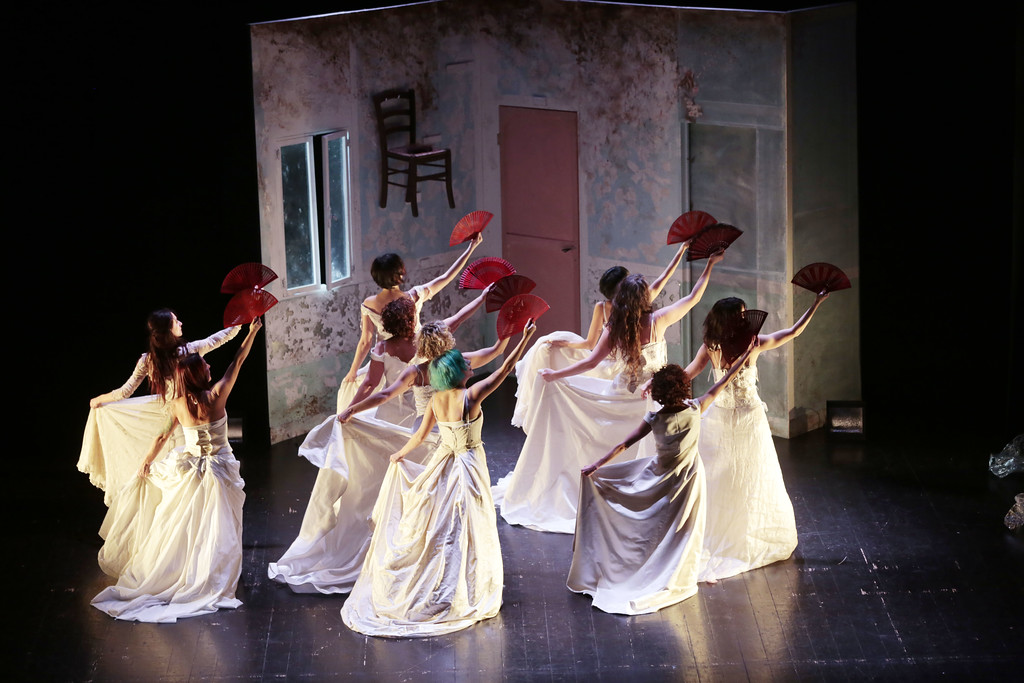
Over at Jacksons Lane: another veteran company returning to the Festival are the David Glass Ensemble, here in collaboration with Topi Dalmata from Italy, bringing together an international cast of performers for the UK premiere of The Brides which cites as its influences Pina Bausch, Mamma Mia, the Marx Brothers, Garcia Lorca and Frida Kahlo. It is directed by David Glass and co-created with Margherita Fusi and Silvia Bruni.
In the opening scene, a sinister mother figure shrouded in black (the Death Bride) activates seven ‘cocoons’ – plastic body bags cum costume bags lying on the ground. Each gives up its contents and here we are – seven young women together with seven bridal dresses, tugged on gleefully or reluctantly or with curiosity. Already we see before us seven strong personalities – no blank slates, no homogenous bodies. Each presents herself to us in all her individual glory, now dressed in her bridal finery, this then disrupted in the most marvellous way. The Brides is billed as a riotous celebration of female misbehaviour, and it delivers. Our ensemble of grrrrls gurn and tweak and stomp and howl and bite and twist and shout to a fabulous soundtrack that ricochets from ‘Love Hurts’ to ‘Real Nitty Gritty’; taking in Elvis Presley’s ‘Crying’, Nancy Sinatra’s ‘Boots’ and Michael Jackson’s ‘Thriller’ along the way. There’s a truly wonderful piss-take – sorry, homage to – Bausch’s choreography to Stravinsky’s ‘Rite of Spring’, all demonic shaking and hair tossing.
But there are gentle moments and dark moments, too, as we move through a cycle of birth, death and resurrection. The relationship between the Death Bride and the Brides sometimes evoke The House of Bernarda Alba. The Velvets’ ‘I’ll Be Your Mirror’ is a recurring motif, delivered by the women standing on chairs or sitting on the floor, gently singing the song whilst wearing blood-red blindfolds across their eyes. This is good, old fashioned (in the best sense of that term) physical theatre: strong but simple staging; inventive lighting; and basic props such as lengths of material, chairs and twigs used to great effect. And of course, it is the strength of the ensemble of eight great performers that wins the day. Bravo, Brides!
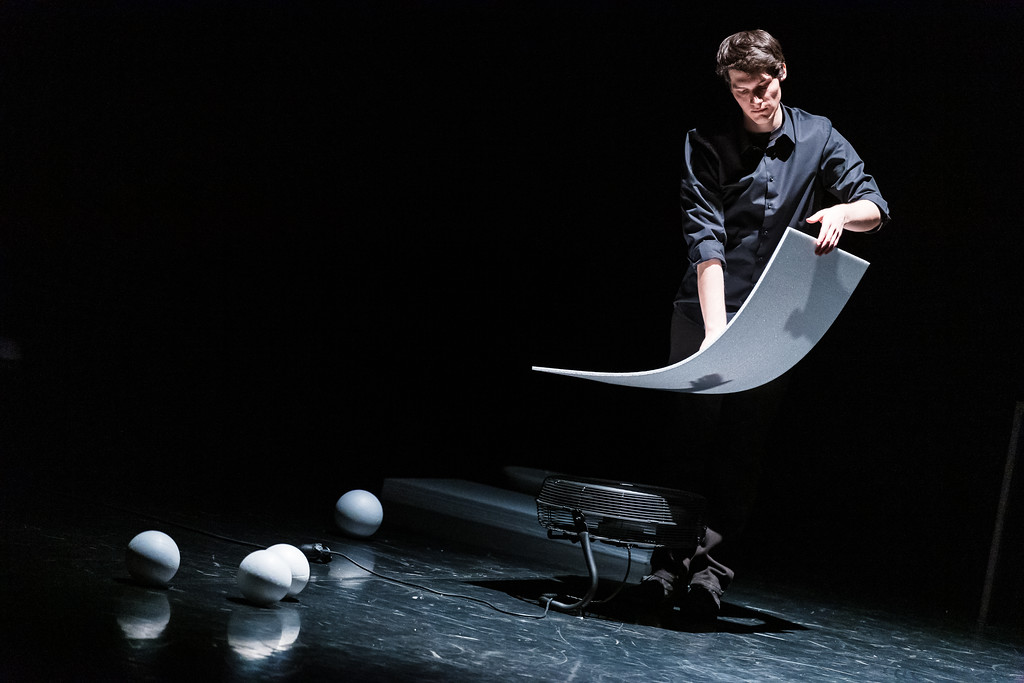
Also at Jacksons Lane: Materia, performed by Andrea Salustri (Italy/Germany) – which I didn’t catch in London, but saw previously at the Edinburgh Fringe 2022.
To quote my Edinburgh review: Materia is as much a demonstration of practical physics and engineering skills as an art show – although all is done with the utmost artfulness. A calm and serious looking young man kneels onstage, leaning over an electric fan which has been placed on its side. He feeds polystyrene balls into the wind current created by the fan and they move around in a circle, jostle each other, and eventually (for some, anyway) get edged out and on to the floor. He steps away, and over to a sheet of polystyrene, which is stacked between two fans which counterbalance each other and keep it upright. This is just the start. Later, there are all sorts of complicated games involving carved or shredded polystyrene, multiple electric fans, and a monochrome lighting plan that plays with the extremities of light and dark, as shadows are cast and strobes highlight the mechanised action. What starts as a straight forward ‘human manipulates object’ scenario evolves into a situation where the objects seem to be calling the shots. Creativity and destruction are balanced out – and there’s plenty of gentle humour too, as we (inevitably) anthropomorphise these polystyrene constructions and create narratives of our own. Here, a mechanical creature asserting its right to survive; there, a tide ebbing and flowing. The final stage picture gives us a grouping of around six automata all firing on full cylinders, accompanied by a great ‘industrial’ soundtrack. It is a truly novel example of brilliant object theatre.
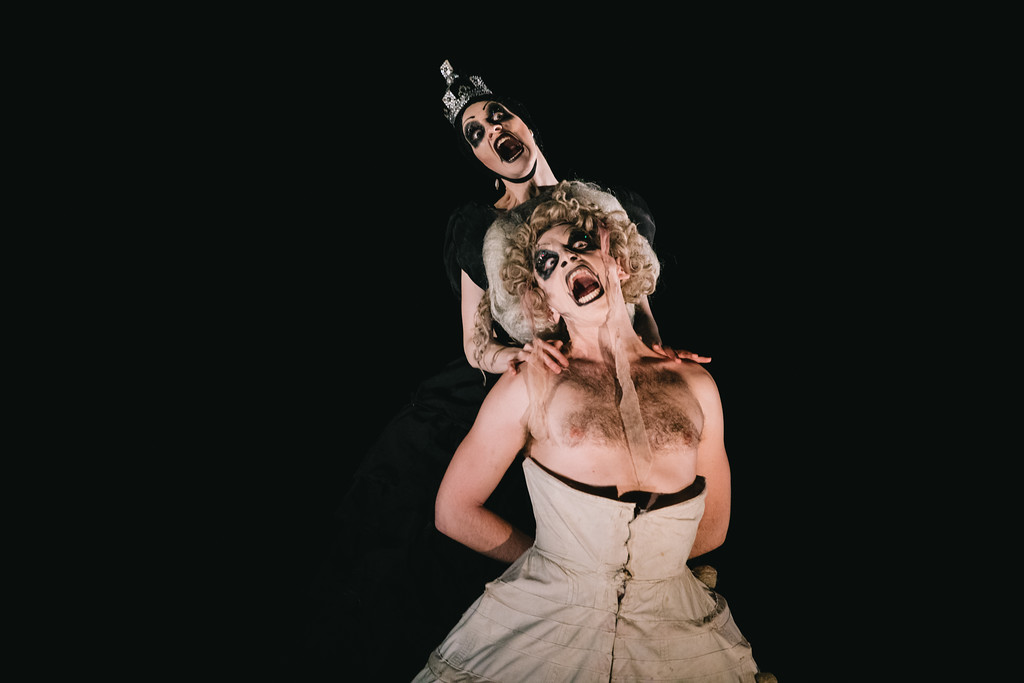
At Shoreditch Town Hall, leading UK visual theatre company Theatre Re returned with The Nature of Forgetting, a LIMF co-commission that was developed with neuroscience professor Kate Jeffery and the Alzheimer’s Society, and performed around the world since its premiere at the Festival in 2017. At the same venue, Thick & Tight (also from the UK) returned to LIMF for the fifth year in succession with Tits and Teeth: A Retrospective of a Dazzling Career, a collection of best bits from their back catalogue. Some all- time favourites return to the stage including the hilarious bouffon encounter between Miss Havisham and Queen Victoria, described thus by Lisa Wolfe in her review at Brighton’s Marlborough Theatre: ‘… a modernist ballet, Queen Have and Miss Haven’t, pitches Queen Victoria against Miss Havisham in a mourning battle… Hair wrenching and breast beating their way through complex choreography that is full of gesture and expression, they compete for the misery prize. Whose loss is greatest, the young widow or the jilted bride? Lit with a rich colour palette that makes great use of shadows, it’s a thrilling ride.’
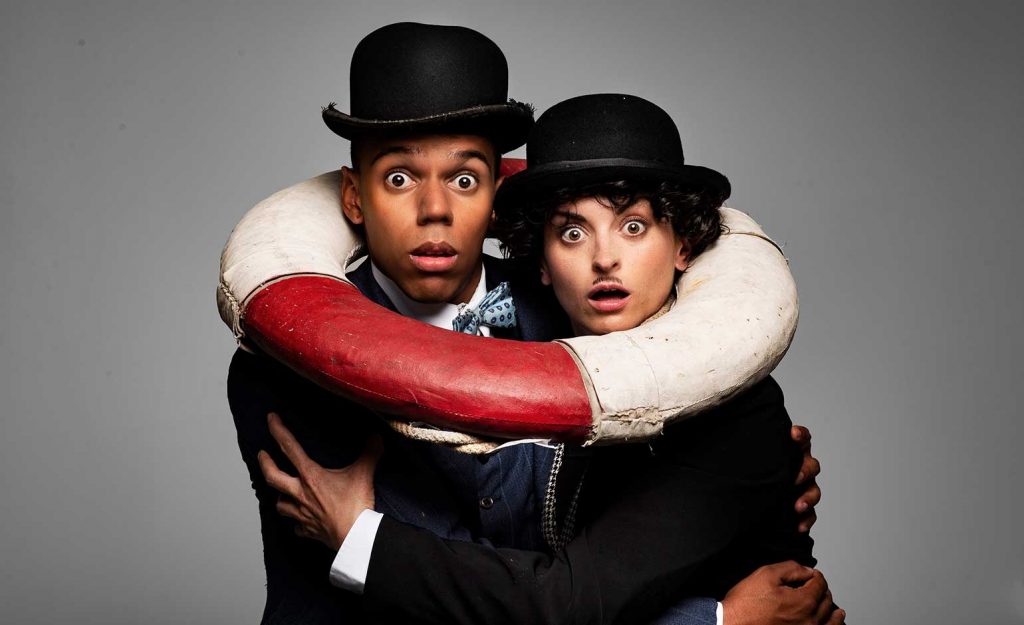
Told by an Idiot are another returning company, back at Wilton’s Music Hall with Charlie and Stan (previously called The Strange Tale of Charlie Chaplin and Stan Laurel). Director Paul Hunterimagines a relationship between Chaplin and Laurel that almost certainly didn’t exist; a ‘comically unreliable’ tribute to these two greats of physical comedy. It could be said that in the retelling of known facts, the re-imagining of the relationship, and the speculation on events that might (in a parallel universe) have occurred, Hunter is inventing the truth. Fabulous physical theatre, and good to see it return toWilton’s, which is such a gorgeous setting, and perfect for this piece.
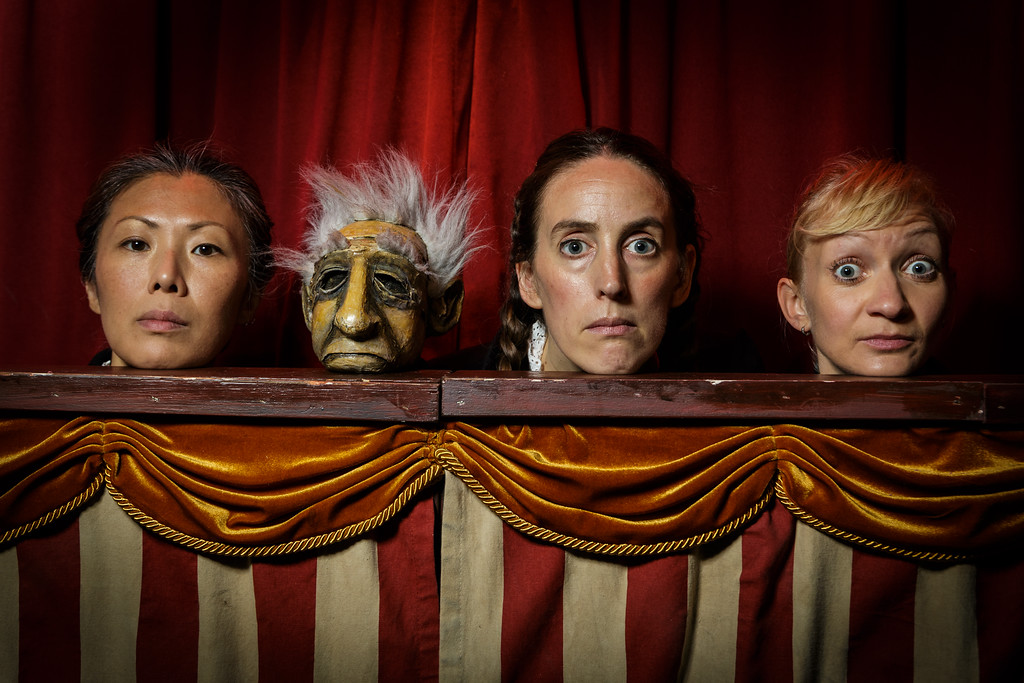
From the depths of the Canadian wilderness The Old Trout Puppet Workshop bring Famous Puppet Death Scenes to The Pit, Barbican. Matt Rudkin described it thus in his review: ‘The central concept, as introduced by an older host (puppet) character, is that by showing us [death] we will be better prepared to face our own mortality. There follow very many scenes featuring the deaths of puppets… The set is impressive: an Art Deco styled construction featuring a central, curtained puppet booth and two smaller booths at each side. Each scene is so varied in style and staging that it is impossible to get bored, and as the show proceeds we get some breathtakingly beautiful and haunting scenes. The soundtrack is artfully chosen to enhance the different moods, and the visual trickery is at times quite extraordinary, and will make you want to rush backstage and see how’s it’s done. It’s all so inventive and exquisitely realised – kind of like the Muppets meets Monty Python meets Tadeusz Kantor.’
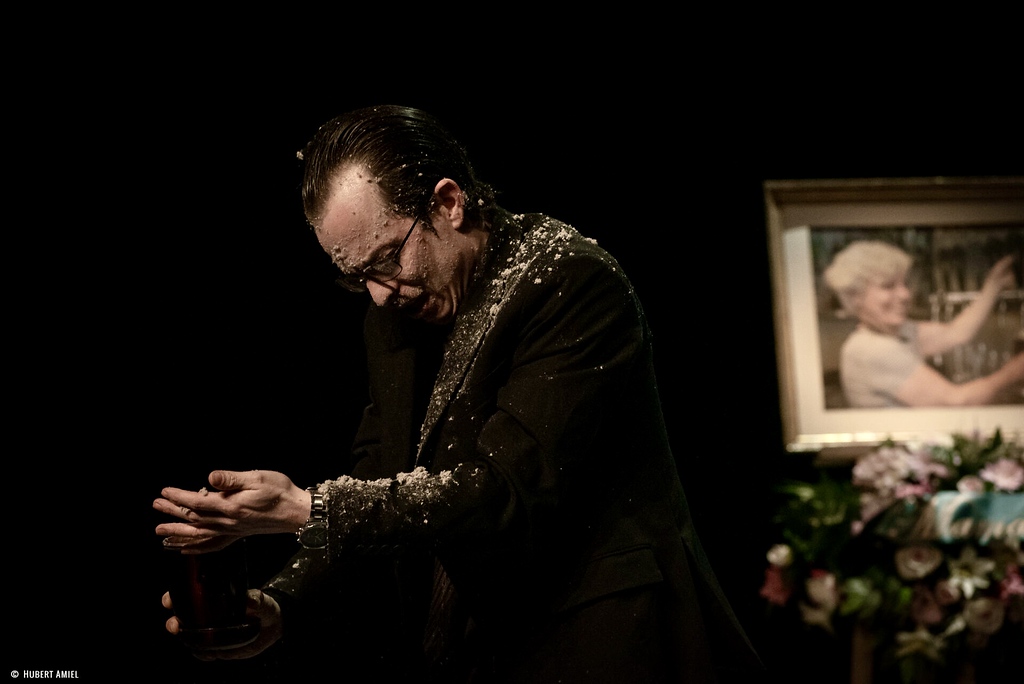
Still Life, rising star of Belgium’s contemporary theatre scene made their UK debut with Flesh, a ‘playful, disruptive drama about our need for affection and recognition’ that played to great acclaim at the Avignon Festival 2022 (read Total Theatre’s previewhere). The show comprises four vignettes. Each of the four pieces, in one way or another, deal with death or transformation of the human body. The first piece investigates the dying body; the second is about modifying the body through plastic surgery; the third investigates the dissociation between body and mind, as played out through a VR experience; and the fourth piece explores re-connecting where there has been disconnection. Each of the four pieces takes one key scenario and works through it with a meticulous care for detail. The central idea is the driver. For example, in the final piece, the question is: what if we place four warring siblings in a room with their mother’s ashes?
Still Life’s work is often described as ‘visceral’. In Flesh, we are not encountering surreal, ambivalent landscapes – the company create tangible environments, peopled by very real and present physical bodies, and then add a twist to the tale. It is the juxtaposing of seeming opposites – the terrible and the funny, the real and the imitation, the present and the absent – that is at the heart of the company’s work, and what makes it such a great success.
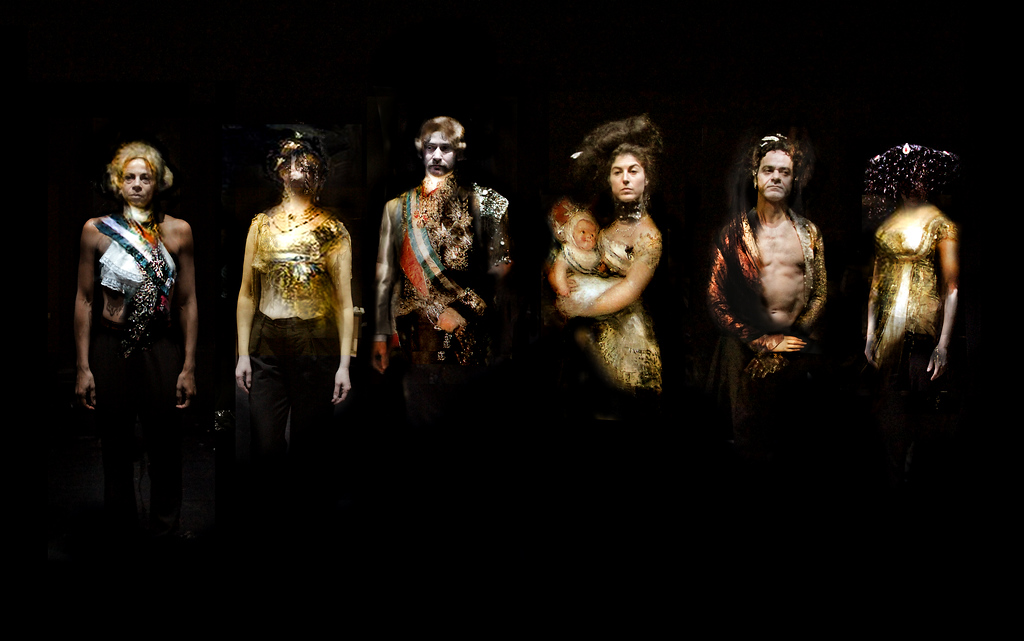
More to come…
LIMF shows still to come at the time of writing (27 January 2023): at The Place, Belgium’s Mossoux-Bonté presents the UK premiere of The Great He-Goat. Inspired by the famous Pinturas Negras of Spanish artist Francisco Goya, Mossoux-Bonté has created a powerful, award-winning work for eleven dancers and their life-size puppet doubles, bringing a museum at night to life.
At the Barbican Pit, Dorothy James & Andy Manjuck (USA) present the UK premiere of Bill’s 44th, a puppet tragi-comedy for grown-ups.
In the Barbican Theatre Belgium’s Olivier Award-winning dance-theatre innovators Peeping Tom present the UK premiere of their new and most ambitious production. Triptych: The missing door, The lost room and The hidden floor – three enigmatic and seductive stories that come together in a trilogy of shifting time, memory and premonition, played out in cinematic scope and atmosphere.
The acclaimed masters of mask-performance Familie Flöz (Germany) return to the Festival for the first time since 2016 with Feste, a clever social commentary about the search for understanding and happiness, presented at the Peacock Theatre.
At Little Angel Theatre, String Theatre’s A Water Journey explores themes of displacement, exile, and the importance of solidarity and friendship in caring for our Earth and her living creatures. Performed with newly created, long-string wood-carved marionettes and silhouette animation.
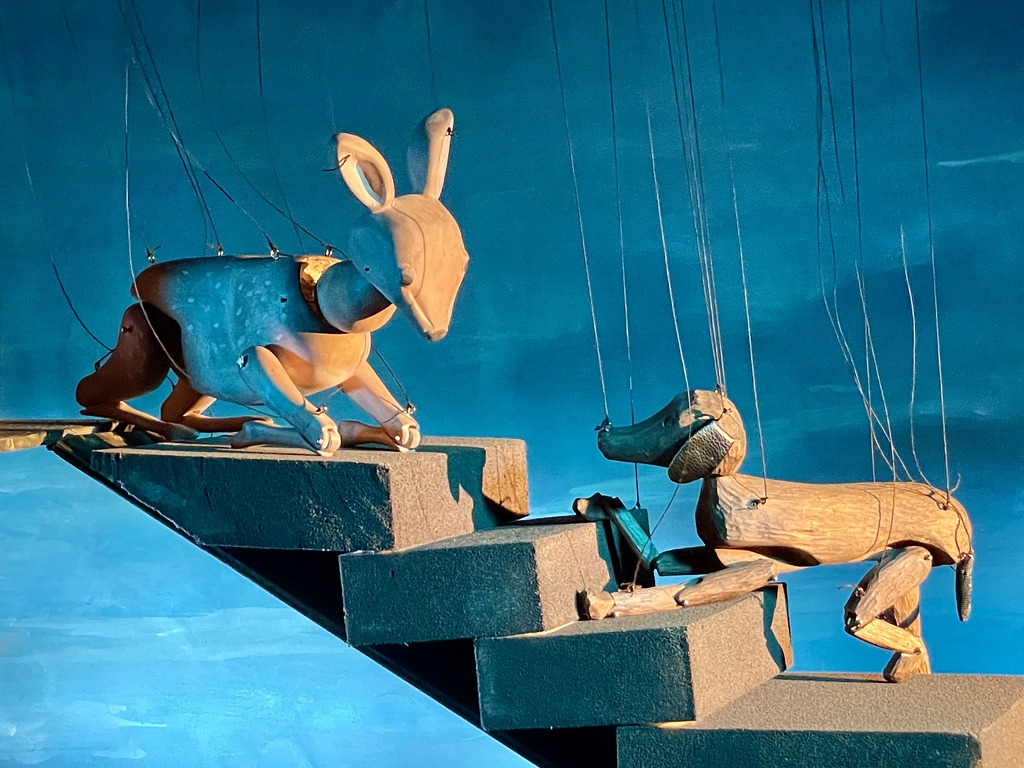
In the film programme: an online screening of Jos Houben & Marcello Magni’s Marcel, dedicated to the memory of Marcello Magni. Online until Sunday 5 February 2023.
London International Mime Festival (LIMF), the UK’s annual festival of contemporary visual theatre, opened on Monday 16 January and runs until Sunday 5 February 2023.
Full programme details and ticket booking for all shows: www.mimelondon.com
A statement from London International Mime Festival: LIMF is evolving. Founded in 1977, its 47th year will see the final edition of the festival in its present form. Directors Helen Lannaghan and Joseph Seelig plan to continue together to promote physical and visual theatre, maintain their consultancy and advisory roles and encourage development of physical and visual theatre artists and innovative work. Further information in due course: mimelondon.com
London International Mime Festival is an Arts Council England National Portfolio Organisation.
